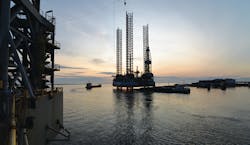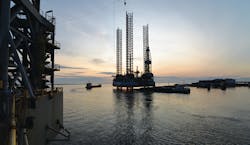TheParagon HZ1 at Rotterdam harbor. (Image courtesy Texo DSI (UKCS)
John Wood
Texo DSI (UKCS)
Drone technology has been in the mainstream psyche for many years, particularly in the military. Only recently have there been opportunities for commercial exploration. The potential for use in the offshore industry is large, both in oil and gas as well as the offshore wind and wave energy markets.
One of the more recent areas where the industry is experiencing tangible benefits is in asset surveying and inspection, particularly in challenging locations or situations which were previously dangerous or inaccessible by humans. Texo DSI (UKCS), the offshore division of Texo Drone Survey and Inspection, is seeking to push the envelope in precision data collection for oil and gas assets. At Offshore Europe in Aberdeen this September, the company presented numerous innovative survey and inspection applications for the industry. The standout demonstration was of the first ever unmanned aerial vehicle (UAV) survey-grade LiDAR scan of an offshore asset, combined with ground-based simultaneous location and mapping (SLAM).
The UAV can collect huge amounts of information during a 32-minute human-controlled flight, mapping a million points per second. The LiDAR (light radar) scan, which pulses laser light at structures and analyzes their reflections, produces about 15GB of data during the brief reconnaissance.
The principle of LiDAR is to measure distances via light in a pulsed laser form and record the time it takes from its generation and subsequent return to calculate distances. Using a specially configured and customized system, up to 1 million laser pulses per second can be measured, leading to 250 scans per second. An accuracy of 1-4 mm can be generated, delivering highly accurate asset information modeling.
So, what does this combination of UAVs and laser technology mean for the industry? The ability to offer high-quality precision data acquisition on projects helps operators make the best engineering decisions at all stages -- from pre-planning through production and finally to end-of-life and decommissioning. Put simply, the scans are much more accurate than ground-based techniques. The technique also removes human risk from hazardous environments where people can be exposed to potential injury.
The technology was tested on theParagon HZ1 jackup drilling rig in the North Sea with the giant T28 platform drone. A team from Texo DSI (UKCS) first travelled to the Port of Esbjerg in Denmark, from where they went on to scan the jackup. Paragon Offshore has already seen the benefits that faster, accurate precision data can offer. Since the LiDAR scan, there has been an improvement in the quality of inspections via more accurate data, rather than relying on eyewitness feedback, and moving to comparative analysis on trends, specifically around corrosion rates. Additionally, the reduction in the risk to personnel, with fewer working at height or in confined spaces, and a more efficient set up, have led to significant economic advantages.
Emerging applications of drones in both engineering and offshore asset lifecycle management could make the take-up of this technology more widespread in the future. Texo DSI (UKCS) recently deployed the world’s first ultrasonic thickness (UT) integrated UAV system, which undertook a wide range of thickness measurement applications and could ascertain precise measurements on both flat and curved surfaces. With the ability to indicate thickness via a unique spot identification system, it will ensure that all UT missions are precise in acquisition and instantaneous in capture and delivery.
The system combines inspection data with a precise photogrammetric visual overlay of the completed survey, pinpointing exact measurement locations on the structure/surface to an accuracy of within 10 mm and delivering verified inspection data. Benefits include an enhanced UT thickness measurement service combined with reduced risk to personnel and efficient of data delivery – data acquisition can be 20 times faster than by traditional methods. This UAV integrated UT payload has been deployed across a wide range of industries, including both offshore and onshore wind turbine structures, telecoms and maritime assets.
One of the key themes from the Offshore Europe exhibition was digitalization coupled with technology. The industry heard a lot about the need to fully embrace the adoption of comprehensive digital platforms as part of what’s been termed ‘the fourth industrial revolution’ through the use of cyber-physical systems. One presenter said: “Data is the new oil.” The oil industry recognizes that great power and imminent breakthroughs can be achieved by using ‘big data’ in smarter, faster ways. As uptake of drone technology increases, the offshore industry will find new ways to use UAVs more productively and for greater safety reward.
Looking further ahead, a drone could also be used to respond to an accident offshore in the first instance or become a quick and key element of search-and-rescue operations. Demand will drive UAV innovators to address the technology’s current limitations, boosting battery and payload capacity (as Texo DSI has done already). And as offshore operators look for new ways to automate tasks to reduce personnel onsite and thus reduce safety risks, increasing demand for drones looks like a safe bet.




